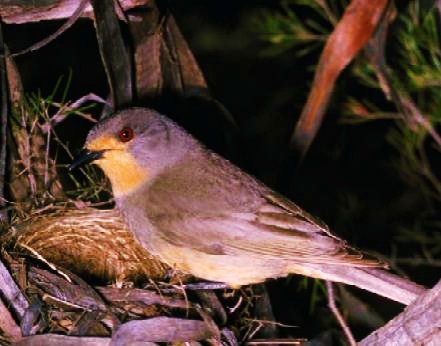Pachycephala rufogularis
Common name:
red-lored whistler (en); sibilante-de-faces-rosadas (pt); siffleur à face rousse (fr); silbador gorjirrufo (es); rotzügel-dickkopf (de)
Taxonomy:
Order Passeriformes
Family Pachycephalidae
Range:
The red-lored whistler is endemic to Australia, only being found in south-eastern South Australia and western Victoria.
Size:
These birds are 19-22 cm long and have a wingspan of 30-33 cm. They weigh 37 g.
Habitat:
The red-lored whistler inhabits low mallee shrublands, heathlands and woodlands that have an open canopy and a moderately dense but patchy understorey.
Diet:
They mainly feed on invertebrates including beetles, bugs, moths, caterpillars and grasshoppers, but also eat some fruits and seeds.
Breeding:
The red-lored whistler breeds in August-November. They build a substantial cup-shaped nest of bark, sticks, leaves and other plant material that is mainly taken from mallee eucalypts. The nest is generally placed in a clump of Triodia and sheltered by a shrub or tree, or in the fork of a malee Eucalyptus, Casuarina, Banksia, Melaleuca or Acacia. The female lays 2-3 white to pink or light buff eggs, which she mostly incubates alone for 14 days. The chicks are fed by both parents and fledge about 2 weeks after hatching, but continue to be fed for a few more weeks.
Conservation:
IUCN status – NT (Near-threatened)
This species has a restricted breeding range and the population may number fewer than 10.000 individuals and is currently suffering a moderate decline. The clearing of malee habitat for agriculture has lead to habitat loss and fragmentation and the species is also threatened by overgrazing and an increase in wild fires.








